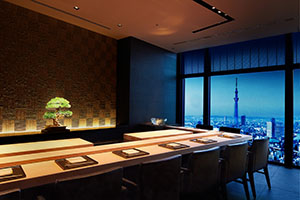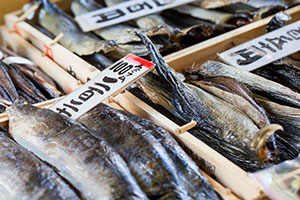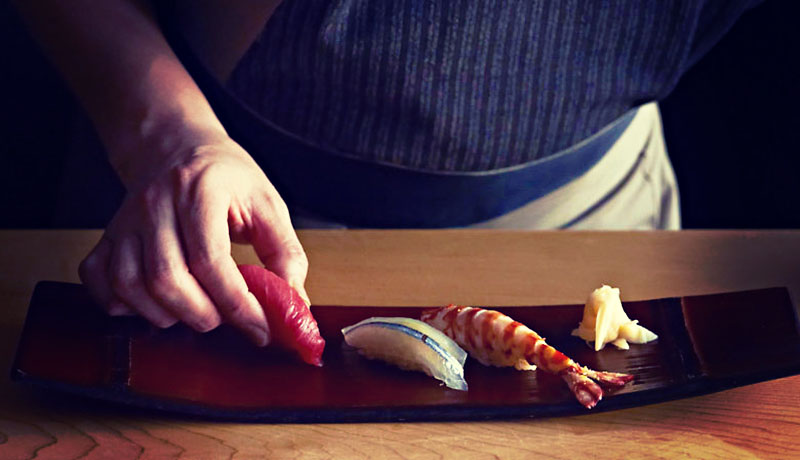
Among the hundreds of dishes that characterize Japanese cuisine, none are more famous, as beloved or as controversial as sushi. Despite a surge in worldwide popularity over the past 20 years, sushi still remains mysterious and foreign for many visitors to Tokyo.
The wide array of different fish types, preparations and restaurants serving it can be daunting, but we’re confident with this declaration: to know raw fish is to love it.
As you might know, some of the most popular fish include mackerel (saba), tuna (maguro), yellowtail (hamachi), snapper (kurodai) and sea bream (tai). The more upscale dishes for brave newcomers to try are uni (sea urchin). This unusual, brown paste is delicious and highly prized among Japanese diners.
Use chopsticks with sashimi (sliced raw fish) and any shared platters. If you order sushi rolls or nigiri sushi (sashimi on rice), it is acceptable to eat them with your fingers. Sushi is served with soy sauce and pickled ginger. Wasabi (hot Japanese horseradish) is optional.
Now that we’ve fed you that basic knowledge, it’s time we direct you toward the best places to feast on some of the fabulousness.
Sushi Sora, Nihonbashi
Tokyo’s sushi bars usually take decades to build a reputation, but Sushi Sora was an instant hit. An elegant restaurant with minimalist décor is complemented by an extravagant view of the city from the 38th floor of Forbes Travel Guide Five-Star Mandarin Oriental, Tokyo in central Nihonbashi.
Enjoy your sushi at the eight-seat wooden counter hewn from 350-year-old Japanese cypress. Your feast of authentic, edomae-style sushi is prepared theatrically, with vim and vigor, and presented in perfect, bite-sized portions.
Pick a rare pour from the award-winning sake sommelier’s collection of quality Japanese alcohol — some of which you may never find anywhere else.
Sushi Yuu, Nishi-Azabu
In a traditional Japanese house, just a few streets back from the bars and clubs of the Roppongi nightlife district, is Sushi Yuu. The English-speaking staff is delightful and will make you feel at home, even if you are unfamiliar with the menu specialty.
Sushi Yuu is famous for its tuna — the fatty belly tuna is especially popular. The chef’s tasting menu is a great way to try everything for those occasions when the selection is too overwhelming.
One other thing about Sushi Yuu that makes it such a hit with foreigners is the extensive wine list, which is quite unusual for a traditional sushi bar. Reservations are highly recommended.
Kaikaya, Shibuya
Another popular place with locals is Kaikaya. This fun, wood-stool-filled izakaya (Japanese pub) specializes in fresh fish, most of which are caught locally. Both Western and Japanese dishes are served here, but the house dazzles with the assorted sushi platter (a very generous serving of sashimi with fresh wasabi) and the tuna “spare ribs,” which are made from bones of the tuna cheek that have tender, sought-after meat attached to them.

Tsukiji Market, Photo Courtesy of Aman Resorts
Kaikaya is noisy and always busy, so it’s understandable that reservations would be necessary here. (Get them a week in advance, if possible.) Slots are usually given in 90-minute increments; after your hour and a half is up, it’s time to leave.
Aman Experience, Aman Tokyo
If you are really serious about your sushi, why not go to the source? The Four-Star Aman Tokyo, a luxurious urban resort at the Otemachi Tower, organizes immersive Aman Experiences — one of which is a tour of Tokyo’s famous Tsukiji Market, the largest wholesale fish market in the world.
The Tsukiji experience, which is exclusive to Aman Tokyo guests, features a morning tour of this fascinating attraction, where you will see the best restaurants, hotels and supermarkets bidding on everything from the cheapest sardines to the most exorbitantly expensive caviar and tuna.
Whale, seaweed, jellyfish, pufferfish and lobster are artistically presented by the many shops inside the market. It’s all quite a sight to behold. The tour includes a tuna-cutting demonstration and optional seafood breakfast.
In the evening, the second part of your epicurean excursion consists of dinner at boutique sushi restaurant, Sushi Kokoro, owned by the tour guide and sushi expert Tsutomu Oba. Oba, known as “Taisho,” will prepare authentic sushi from the fish purchased at the market that morning.
The culinary experience, including the tour and dinner, runs daily, except for Wednesday and Sunday.


